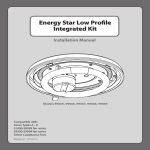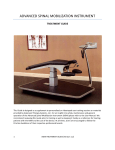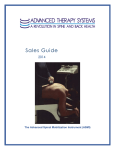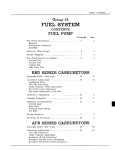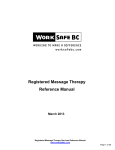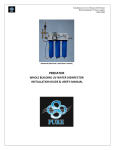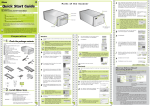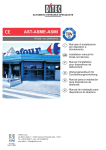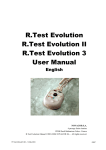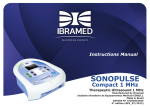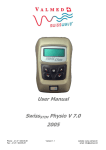Download ASMI - User Manual - Advanced Therapy Systems
Transcript
ADVANCED SPINAL MOBILIZATION INSTRUMENT USER MANUAL This document has been prepared to give the user an insight into safety, maintenance and general operation of the Advanced Spinal Mobilization Instrument (ASMI). Also incorporated are guidelines on specifications and spare parts. It is recommended that this document be read prior to initial use as well as a reference for continuous use in order to familiarize the operator with an electro-pneumatic system as well as guidelines on the individual operational settings and the use of the device. 1 ASMI USER MANUAL (Version 1.01) Table of Contents GENERAL INSTRUCTIONS AND SAFETY .......................................................................................... 3 Compressed Air Safety ......................................................................................................................... 3 Operator Safety When Using the ASMI .............................................................................................. 3 Constituents of the ASMI System ........................................................................................................ 4 Operation ................................................................................................................................................. 6 ASMI Display and Keyboard Layout................................................................................................ 6 Using the ASMI ................................................................................................................................... 7 Maintenance............................................................................................................................................ 7 Filter Maintenance .............................................................................................................................. 7 Troubleshooting .................................................................................................................................... 10 Specifications ........................................................................................................................................ 12 General Spare Parts Listing ............................................................................................................... 12 Storage and Transport Conditions..................................................................................................... 12 Compressor recommendations .......................................................................................................... 12 Warranty .................................................................................................................................................... 12 2 ASMI USER MANUAL (Version 1.01) GENERAL INSTRUCTIONS AND SAFETY Compressed Air Safety Compressed air represents a source of considerable potential energy and, as with electricity, precautions must be taken to prevent accidents. Compressed air should never impinge upon the body. Ports and pipes etc. should never be blocked by hand. Before connecting any pneumatic equipment to compressed air supply, mountings, fittings, pipe work and electrical connections should be checked for security and all or any plastic plugs removed . No pipe work alterations or removal of fittings should be attempted with air supplies connected. Air and electrical supplies must be disconnected before any maintenance is undertaken. The maximum allowable operating pressures, electrical supply, temperature, loads etc. should be observed. Refer to "Technical Information" in this manual for this information and for any other operating limits. The guidelines outlined above, however, are for general compressed air usage. It should be noted that the only external components of the ASMI which are compressed air sources are: • • • • The main air supply line from the compressor to the console unit and its subsequent connection to the ASMI. This is comprised of specialized coupling fittings, which, even when disconnected, will not allow the escape of compressed air. The pneumatic handset assembly incorporating four pneumatic pistons connected to the control console by coiled tubing. This unit is completely sealed and is simply plugged (for both electrical and air supplies) into the front face of the control console. Never press "RUN" on the control console unless the handset is held firmly in the operator's hand. The pneumatic actuators built into the handset will reciprocate with force. The two-stage compressed air filter assembly. Air supply connection to and from these filter units is provided internally by the ASMI control console. These filter units require only routine maintenance (refer to "Filter Maintenance"). The factory-set compressed air regulator unit between the two filters. Without this regulator, air would be supplied from the compressor at too high a pressure, resulting in damage to internal components. The regulator is factory-set and as such will need no adjustment and is maintenance-free. Air supply connection to and from the regulator unit is provided internally by the ASMI. Operator Safety When Using the ASMI The ASMI assembly is a complete operating electro-pneumatic system. The operator should never open or dismantle any part of the unit other than during the process of carrying out routine maintenance of the filter elements (refer to "Filter Maintenance"). Opening or dismantling any part of the unit other than during filter maintenance will invalidate the warranty. 3 ASMI USER MANUAL (Version 1.01) The operator should also be aware of the following safety guidelines. Failure to follow these guidelines will invalidate the warranty. • • • • • • • • • • • • • • • Protect your ASMI from strong impacts. Be careful not to drop it or place heavy objects on it. Avoid applying excessive force to the controls and keys. Always unplug cables by gripping the plug firmly and not by pulling the cable. The ASMI should be situated away from any heat sources such as radiators. Avoid exposure to direct sunlight or other sources of heat. Avoid highly humid or dusty places. Due to sensitive internal electrical components, the system should never be used near water or where a damp atmosphere or moisture is present. Due to the reliance of the filter units on material gathering in the base of the bowls, the ASMI unit should only be used on a level surface. Ensure all air connections to the ASMI are secure before supplying compressed air to the system. Do not exceed the maximum supply pressure of the ASMI (refer to "Specifications"). Should abnormal air leakage be heard from any part of the ASMI assembly, turn the air and electrical supply OFF at the source immediately and contact Advanced Therapy Systems. Though not essential, it is good practice to ensure that the air supply is turned off at the source, before removing the supply fitting. The ASMI is supplied with highly flexible air and electrical connection lines. Nevertheless, it is important to ensure that the tubing never kinks and that regular inspection is conducted in order to check for deterioration of the tubing material. All checking or servicing of filter elements (i.e., when bowls are removed from the filter units) should be carried out while the air and electricity supply are disconnected from the ASMI. Unplug the AC adaptor from the electrical outlet if the instrument is not to be used for long periods of time or during electrical storms. If an abnormal smell or smoke is detected, immediately turn air and electrical supplies OFF and remove the main adaptor unit from of the socket. Contact Advanced Therapy Systems. When cleaning, never use volatile solvents such as alcohol, paint thinner or benzene. Use a clean dry cloth. Do Not use talcum powder with or near the ASMI, as this will damage the unit. If the ASMI unit is to be moved, it is important to ensure that the filter bowls are drained and there is no water in the bowls. See "Filter Maintenance." Failure to drain the filter bowls before moving the unit may saturate the filters with water and oil deposits, which will be transferred through to the sensitive instrumentation in the equipment and lead to malfunction and failure. Constituents of the ASMI System In order for the ASMI to operate efficiently, clean, high quality compressed dry air is essential for longterm operation. Correct air preparation can minimize the risk of component failure and generally result in a longer life expectancy of the pneumatic components. 4 ASMI USER MANUAL (Version 1.01) Contaminants naturally occurring in the atmosphere such as dust, grit and pollen are compressed at the same time as the air and, unless filtered, will be circulated throughout the system. These particles may, in low concentrations, be no danger to the system. However, combined with forms of moisture (usually water vapor which naturally occurs in the air), will eventually solidify and gradually accumulate on both static and moving surfaces within the pneumatic equipment. This will cause the valves to stick, seals and other components to wear, and ultimately lead to failure of the device. Due to the large cycles of reciprocating actuation experienced within the handset, a two-stage filter system has been incorporated within the ASMI and, if routinely maintained, will result in effective operation of the unit. The filtered matter, usually in the form of moisture, will in time build up at the bottom of the two filter bowls and should be checked after 8 hours of usage or every day and drained accordingly. Refer to "Filter Maintenance" on how to drain the filtered matter. The first stage Filter has an element which is capable of 5 µm filtration. This filter is intended to remove the larger contaminants in the airline supply from the compressor. It is recommended that this filter element be replaced on a yearly basis and should be routinely checked after 2,000 hours of use. The second stage Filter incorporates a micro-filter cartridge element which is capable of 0.3 µm filtration. This secondary factory-set filter is placed in line after the first filter and removes dust and oil mist as well as supersaturated moisture. It is recommended that this element be replaced on a yearly basis. It should be routinely checked after 2,000 hours of use. The four electrical and air connections incorporated in the ASMI are all specific for their particular use and are not interchangeable. Refer to Figure 3. • • • • To connect the main air supply line to the control console, ensure the female coupling from the compressor line is placed over the male connection (2) and pushed firmly "home" until the coupling locks. To remove the connection, hold the socket in place and pull the collar away from the control console. To connect the electrical supply, insert the plug from the main adapter unit into the mating socket (3). When connecting the air line for the handset into the control console, place the male plug from the handset line into the mating coupling on the front face of the console and push firmly until the fitting locks into position. To remove the connection, push the collar towards the control console. To connect the electrical supply from the control console to the handset, ensure that the fourpin plug is aligned with its mating socket on the front face of the control console. Once the plug is fitted into the socket, secure the connection by turning the lock ring supplied with the plug clockwise until finger tight. When all four connections have been made, the ASMI is ready for use. Turn on both air and electrical supplies. 5 ASMI USER MANUAL (Version 1.01) Operation ASMI Display and Keyboard Layout The keyboard on the control console is divided into three main sections. - Introductory, Reflex and Mobilize. Selection of the required mode is made by pressing the appropriate Mode change button. The Effort (or intensity) and the Frequency for each mode can be adjusted up or down using '+' or '-' buttons (refer to figure1). The left digit on the numeric display, below each Mode Change Button, displays the Effort level. The right digit displays the Frequency level. The RUN and STOP buttons activate and deactivate the Handset once a mode has been selected. Figure 1. (Console Layout) The Bar graph LED display gives a visual representation of the Force and Frequency settings in each mode. 6 ASMI USER MANUAL (Version 1.01) Using the ASMI The AST Spinal Mobilization Instrument is the first technology-assisted instrument for the physical therapist or other licensed medical professional to consistently and effectively perform Maitland's spinal mobilization techniques. Treatments alternate between the threes modes: Introductory, Reflex and Mobilization • • • Introductory Mode: After the patient has comfortably positioned him/herself on the treatment table, initiate the Introductory mode and, with a gentle touch, run the handset along the length of the spine. The setting lasts for 15 seconds and serves to acclimatize the patient to the touch and feel of the handset on the back and spine. Reflex Mode: Cradle the handset with both hands and allow it to move along the length of the spine, stimulating the reflexes of the paraspinal muscles from the lumbosacral to the thoracocervical junction. Initiate this mode immediately after the introductory mode and periodically during the mobilization mode. Mobilization Mode: Begin in the sacral area at low settings and gently but firmly apply pressure to the handset to mobilize the vertebral articulations. Slowly move up and down the spine from the lumbosacral to the cervico-thoracic areas keeping the handset centered over the spinous processes and allowing the pads of the handset to gently mobilize spinal segments by exerting pressure on the transverse processes. Maintenance Filter Maintenance Check every day before use or after 8 hours usage If water has built up in either of the two Filter Bowls, please take the following steps, referring to Figure 2 below. If water in the Filter Bowls is a regular occurrence, contact Advanced Therapy Systems as there may be an issue with the compressor. a) Connect the main air supply to the console through its respective socket (2). This will pressurize the system facilitating the condensate drain. b) Press the button (C), located at the bottom of the Filter Bowl (B). Warning - When draining the moisture from the Filter Bowl, ensure the use of a suitable container to catch expelled moisture. NOTE: The fluid will be discharged from the bowl under pressure and suitable caution should be taken. c) When the moisture is fully drained and only air is being expelled from the filter unit, release the button (C). For best practice, briefly purge the filter bowls every working day even though there may be no visible accumulation of moisture. This daily habit ensures the best air quality for your equipment and prevents the accumulation of significant amounts of condensate. If conducted daily, a facial tissue is usually sufficient to absorb the moisture that is present. 7 ASMI USER MANUAL (Version 1.01) No A B C Description Filter Unit Filter Drain Bowl White Drain Button Figure 2. Filter Bowl Check every year or after 2,000 hours usage. Checking and changing the filter elements for contamination (Refer to Figure 3). Poor quality air supplied from the compressor can cause contamination and create blockages within the filter element. This could cause a pressure drop and affect the efficiency of the unit. When the element is very dirty, it should be replaced. When the bowl is dirty, it should be washed using a neutral cleanser. To check and, if necessary, replace the filter elements, the following steps should be taken: a) Ensure that the main air pressure line and the electrical plug are disconnected from their respective sockets (2) & (3). It is recommended that the following steps be carried out in a clean environment to prevent any contamination. b) Remove the preliminary Filter Bowl (8) by pushing down the black release clip (10), twist the Drain Bowl clockwise until the vertical lines on the filter body line up with vertical lines on the Drain Bowl, making sure the black release clip is held down. c) Now gently pull the Bowl (8) away from Filter Body (6). d) Remove black Baffle plate (12) by unscrewing. Caution: Ensure that Baffle plate (12), element (13) and deflector (14) do not drop. If a replacement 5 µm element is required for stage 1, use or request the following preliminary filter replacement part: Replacement 5 µm filter element (13) part number: 111585A e) Replace Deflector (14), Element (13) and Baffle (12) back onto mounting stud and screw the Baffle to secure. Caution: Tighten by hand only. f) Replace the Bowl (8) back into location grooves in the bottom of the filter unit (6), ensuring the vertical lines line up. Twist the Bowl until the black release lever (10) locks, indicating that the catch has been made and that the Bowl is secured once again to the Filter Body. 8 ASMI USER MANUAL (Version 1.01) g) Remove the secondary filter Bowl (9) by pushing down the black release clip (11), twist the drain Bowl (9) clockwise until the vertical lines on the Filter Body line up with vertical lines on the drain bowl, making sure the black release clip is held down. h) Now gently pull the Bowl (9) away from Filter Body (7). i) Remove the micro filter element by unscrewing from the mounting stud. If a replacement O.31 µm element is required for stage 2, use or request the following micro filter replacement part: Replacement O.31-lm micro Filter element (15) part number: 630617 j) Secure the Element (15) back onto mounting stud by turning counter-clockwise. Caution: Tighten by hand only. k) Replace the Bowl (9) back into location grooves in the bottom of the filter unit (7). Ensure the vertical lines line up, twist the Bowl until the black release lever (11) locks, indicating that the catch has been made and that the Bowl is secured once again to the filter body. l) Re-connect the air and electrical supplies to the relevant socket (2) & (3) on the control console. The ASMI is now ready for use again. Should there be an air leakage from either of the filter units, disconnect the electrical and air supplies before checking the seating between the bowl and the main filter unit housing. If the problem persists, contact Advanced Therapy Systems. Rear view on control console 9 ASMI USER MANUAL (Version 1.01) No. 1 2 3 4 5 6 7 8 Description ASMI Control Console Mains Air in Connection Fitting Electrical In Connection Socket Fuse Holder Socket Factory Set Regulator Unit Stage 1 (Preliminary) Filter Stage 2 (Secondary) Micro Filter Stage 1 Filter Bowl Spares PT No. not available not available not available not available not available not available not available C300F No. 9 10 11 12 13 14 15 - Description Stage 2 Filter Bowl Stage 1 Bowl Release Clip Stage 2 Bowl Release Clip Black Baffle Plate Stage 1 (5µm) Filter Element Deflector Plate Stage 2 (0.3µm) Filter Element 1A Fuse Spares PT No. C300F not available not available not available 111585A not available 630617 415-569 Troubleshooting a) THE CONSOLE DISPLAY DOES NOT LIGHT If the console display does not light, electrical power is not being supplied to the console. Begin by checking that the power point and any extension leads are in good working order. Before reconnecting the ASMI power supply, check the fuse, which is located at the back of the console. The position of the fuse holder is illustrated on page 9, item 4. Using a suitable screwdriver, release the fuse from the housing (item 4) by turning the screw counter clockwise. The fuse wire, contained within the glass cylinder, should be intact and continuous. If in doubt, change the fuse. This is a special fast blow fuse, which is designed to protect the electronics from power surges. A spare fuse (part number 415-569) was supplied with your ASMI. If the power point, extension lead (if used) and the fuse are in good working order, then the ASMI power supply may have developed a fault. Contact Advanced Therapy Systems. Do not substitute a power supply from some other apparatus because the output and level of protection may not be suitable. b) THE CONSOLE DISPLAYS 'Error' If the console displays an error message, the most likely cause is lack of air supply. Begin by switching off electrical power to the console. This will clear the error message and reset the electronics. With electrical power to the console off, check that the compressor is switched on and that the supply valve is open. Press a drain button on one of the filters at the back of the console, as described on page 8 Filter Maintenance (c) and hold the drain open for a few seconds. If a normal flow of air is expelled, the airway to the console is open. Inspect the pressure gauges on the compressor and check that both are reading 85 psi or more. Now switch electrical power to the console back on, if the error message persists, report the failure to Advanced Therapy Systems. Do not tamper with the unit; doing so will invalidate the warranty. c) ONE PAIR OF PISTONS ON THE HANDSET SEEMS TO BE WORKING BETTER THAN THE OTHER PAIR This does not imply a malfunction. The handset incorporates airways which must carry a relatively large volume of air. Because the airways to one pair of pistons are slightly longer than the airways to the other pair, if a low intensity and fast rate is selected in Introductory mode, for 10 ASMI USER MANUAL (Version 1.01) example, the pistons will barely move because they receive the instruction to react before they have had time to extend. As the effort is increased or the rate is slowed, the pistons have more time to respond. d) THE PISTONS STUCK After the handset has been at rest for a while, some 'sticking' will be felt when the pistons are first moved. Again, this is neither a malfunction nor a design fault. It is a characteristic of the design, the materials of the piston seals, and the lubricant, which combine to give long life in hard service. The pistons are lubricated for life. Do not try to introduce additional lubrication. Do take care to keep the handset well away from powders such as talcum. The powder will combine with the lubricant on the extended piston rods (legs) to form a grinding paste. This paste will destroy the seals and the smooth operation of the handset. Evidence of powder contamination will invalidate the warranty on the handset. e) WHEN IN INTRODUCTORY MODE, THE UNIT STOPS AND SWITCHES TO REFLEX MODE This is a design feature. After 15 seconds in Introductory mode the unit will switch to Reflex Mode in a stop condition. Should the need arise, the clinician may continue in Introductory mode by selecting INTRODUCTORY and then START. However, the system will continue to stop and switch modes after 15 seconds. This feature has been incorporated to discourage overuse of the introductory mode as excessive use of the mode will significantly shorten the life of the handset. The ASMI console incorporates a sophisticated system which monitors its own performance and calibrates internal components to ensure optimum performance. If the system cannot achieve optimization, then it will shut down and display Error. Thus, if it is working, it is working within its specifications. The console does not monitor performance of the handset. However, the handset does not contain components that require calibration. If you are still concerned about the performance of your handset, contact Advanced Therapy Systems. 11 ASMI USER MANUAL (Version 1.01) Specifications Overall Control Console Dimensions Overall Handset Dimensions Medium Maximum Supply Pressure Minimum Supply Pressure Maximum Operating Temperature (Air) Unit Regulator set to Lubrication Supply Voltage (To Adapter) Internal Operating Voltage (From Adapter) Power Consumption Stage 1 Filtration Level Stage 2 Filtration Level Length: Width: Depth: 390 mm 310 mm 155 mm Length: Width: Depth: 85 mm 60 mm 70 mm Clean, dry and oil free compressed air 2 7.03 Kg/cm (100psi) 2 6.3 Kg/cm (90psi) 50° C (no condensation) 2 6.3 Kg/cm (90psi) Not Required 230 V-50Hz AC 12 V D.C. 15 Watts 5µm 0.3µm Weight: 616 Kg Weight: .7 Kg General Spare Parts Listing Description 1A Fuse Handset Rubber Foot x 4 Stage 1 Filter Element (5µm) Stage 2 Filter Element (0.3µm) Plug Adapter (240V AC / 12v D.C ) Stage 1 Filter Bowl Stage 2 Filter Bowl Handset Assembly Part No. 415-569 P02006/FOOT 111585A 630617 LZESK02003MB012H C300F C300F PAM-HANDSET Storage and Transport Conditions Temperature Relative Humidity 32° to + 158° F (0° to + 70° C) 5% to 85% non-condensing Compressor recommendations Any compressors used in conjunction with the ASMI should comply with medical standards and must be used within the manufacturer's specifications. Warranty This product is guaranteed for twelve months provided it is used in the recommended manner. There are no user serviceable parts within either the control console or the handset of the ASMI. Any unauthorized tampering with the equipment will render all warranties void. For all service and repair requirements beyond the scope of this manual, please contact Advanced Therapy Systems. 12 ASMI USER MANUAL (Version 1.01) EXPLANATION OF SYMBOLS CE Approved. This product meets the requirements of the Medical Devices Directive 93/42/EEC Attention, consult accompany documentation or manuals Class II equipment Shock protection Type B equipment The ASMI unit complies with IEC 601-1-2 (1993). However, this does not guarantee that other equipment in the vicinity will not be affected by electromagnet emissions from the unit. Similarly, other equipment in the vicinity may affect the operations of the unit. It is recommended that all equipment used near the unit comply with the relevant electromagnetic compatibility requirements for the equipment and to check before use that no interference is evident or disruptive. Increasing the distance between offending devices and keeping interconnecting leads as short as possible will help reduce the effect. For more information visit us at: http://www.advancedtherapysystems.com 13 ASMI USER MANUAL (Version 1.01)













